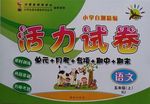题目内容
One can't speak English well ______ he has enough practice.
- A.unless
- B.if
- C.if only
- D.if not

 活力试卷系列答案
活力试卷系列答案 课课优能力培优100分系列答案
课课优能力培优100分系列答案There is a lot of misunderstanding about studying. Most students have not been taught the principles behind really effective working. Imagine a graph showing the amount a person learns against the number of hours he works in a day. If he doesn’t do any work, he learns nothing (point 0). If he does an hour’s work he learns a certain amount (point 1). If he does two hours’ work he learns about twice as much (point 2). If he does more work he’ll learn still more (point 3). However, if he tries to do twenty-three and a half hours’ work in a day, he will be so tired that he’ll hardly remember anything: what he learns will be very little (point 4). If he did less work he’d learn more (point 5).
Now whatever the exact shape of the graph’s curve(曲线), made by joining these points, it must have a high point. Point “X” is the very maximum anyone can learn in the day. And this represents the optimum(最适度), the best, amount of work to do. It is the best possible compromise between adequate time at the books and fatigue(劳累). Fatigue is an absolutely real thing; one can’t escape it or ignore it. If you try to ignore it and press yourself to work past the optimum, you will only get on this downward slope and achieve less than the best – and then become very tired and lose your power of concentration.
The skill in being a student consists of getting one’s daily study as near the optimum point as possible. I cannot tell you what the optimum is. It differs with the type of work, it differs from person to person, and even in the same person it varies from week to week. You must try to find your own. Every day you study, bear this principle of the optimum in mind. When you feel yourself getting fatigued, if you find yourself reading the same paragraph over and over again and not taking it in, that’s a pretty good sign you’ve reached your highest point for the day and should stop. Most ordinary students find their optimum at five hours a day. Yours may be a little more or a little less – but if you get in five hours’ good work a day, you will be doing well.
Now, what are you doing with yourself when you aren’t working? Before examinations some students do nothing at all except sit in a chair and worry. Here is another misunderstanding. People often think that the mind works like the body; it does not. If one wanted to save one’s physical energy in order to cut the maximum amount of firewood, one would lie flat on a bed and rest when one wasn’t chopping. But the mind cannot rest. Even in sleep you dream, even if you forget your dreams. The mind is always turning. It gets its relaxation only by variety. That is what makes the mind rest.
When you’ve finished your optimum number of hours you must stop. You must not then sit around in the chair thinking about the work – that only tires without any learning. You must get out and do something. It doesn’t matter what – anything so long as you are actively doing something else but work.
【小题1】According to the passage, _______.
| A.the longer you study every day, the more you will learn |
| B.you’ll achieve better learning results if you work three hours every day |
| C.the less work you do, the better you will learn |
| D.your work efficiency will decrease once you exceed a certain point of work |
| A.loss of memory | B.a need for relaxation |
| C.a lot of anxiety | D.loss of concentration |
| A.follows a regular pattern with each individual |
| B.changes regularly from week to week |
| C.can be partly determined by the sort of work he is doing |
| D.should be determined before he gets too tired |
| A.doing a variety of things in turn |
| B.not thinking about anything |
| C.turning continuously |
| D.getting oneself in a state of fatigue |
| A.lie in bed and rest |
| B.do something else actively |
| C.do some physical labor |
| D.stop thinking about your studies |
There is a lot of misunderstanding about studying. Most students have not been taught the principles behind really effective working. Imagine a graph showing the amount a person learns against the number of hours he works in a day. If he doesn’t do any work, he learns nothing (point 0). If he does an hour’s work he learns a certain amount (point 1). If he does two hours’ work he learns about twice as much (point 2). If he does more work he’ll learn still more (point 3). However, if he tries to do twenty-three and a half hours’ work in a day, he will be so tired that he’ll hardly remember anything: what he learns will be very little (point 4). If he did less work he’d learn more (point 5).
Now whatever the exact shape of the graph’s curve(曲线), made by joining these points, it must have a high point. Point “X” is the very maximum anyone can learn in the day. And this represents the optimum(最适度), the best, amount of work to do. It is the best possible compromise between adequate time at the books and fatigue(劳累). Fatigue is an absolutely real thing; one can’t escape it or ignore it. If you try to ignore it and press yourself to work past the optimum, you will only get on this downward slope and achieve less than the best – and then become very tired and lose your power of concentration.
The skill in being a student consists of getting one’s daily study as near the optimum point as possible. I cannot tell you what the optimum is. It differs with the type of work, it differs from person to person, and even in the same person it varies from week to week. You must try to find your own. Every day you study, bear this principle of the optimum in mind. When you feel yourself getting fatigued, if you find yourself reading the same paragraph over and over again and not taking it in, that’s a pretty good sign you’ve reached your highest point for the day and should stop. Most ordinary students find their optimum at five hours a day. Yours may be a little more or a little less – but if you get in five hours’ good work a day, you will be doing well.
Now, what are you doing with yourself when you aren’t working? Before examinations some students do nothing at all except sit in a chair and worry. Here is another misunderstanding. People often think that the mind works like the body; it does not. If one wanted to save one’s physical energy in order to cut the maximum amount of firewood, one would lie flat on a bed and rest when one wasn’t chopping. But the mind cannot rest. Even in sleep you dream, even if you forget your dreams. The mind is always turning. It gets its relaxation only by variety. That is what makes the mind rest.
When you’ve finished your optimum number of hours you must stop. You must not then sit around in the chair thinking about the work – that only tires without any learning. You must get out and do something. It doesn’t matter what – anything so long as you are actively doing something else but work.
1.According to the passage, _______.
|
A.the longer you study every day, the more you will learn |
|
B.you’ll achieve better learning results if you work three hours every day |
|
C.the less work you do, the better you will learn |
|
D.your work efficiency will decrease once you exceed a certain point of work |
2.Fatigue can result in ________.
|
A.loss of memory |
B.a need for relaxation |
|
C.a lot of anxiety |
D.loss of concentration |
3.The passage tells us that a person’s optimum number of working hours _______.
|
A.follows a regular pattern with each individual |
|
B.changes regularly from week to week |
|
C.can be partly determined by the sort of work he is doing |
|
D.should be determined before he gets too tired |
4.The only way the mind can relax is by ________.
|
A.doing a variety of things in turn |
|
B.not thinking about anything |
|
C.turning continuously |
|
D.getting oneself in a state of fatigue |
5.After you have reached the optimum point of study in a day, you should ________.
|
A.lie in bed and rest |
|
B.do something else actively |
|
C.do some physical labor |
|
D.stop thinking about your studies |
There are many different ways of seeing a town for the first time. One of them is to walk around it, guide-book 36 hand. Of course, we may 37 with our guide-books the history and 38 developments of a town and get to know them. 39 then, if we take out time and 40 in a town for a while, we may get to know it better. When we 41 it as a whole, we begin to have some 42 ,which even the best guide-books do not answer. Why is the town just 43 this, this shape, this plan, this size? Why do its streets 44 in this particular way, and not in any 45 way?
Here even the best guide-book 46 us. One can’t find in it the information about how a town has developed to the 47 appearance. It may not describe the original (最初的) 48 of a town. However, one may get some idea of what it 49 look like by walking around the town. One can also imagine 50 the town was first planned and built . Then one can learn more about in what direction the town 51 to develop.
What is the 52 of studying towns in the way? For me, it is 53 that one gets a greater depth of pleasure by visiting and seeing a town with one’s own eyes. A 54 visit to a town may help one better understand why it is attractive 55 just reading about it in a guide-book.
|
1. |
|
|
2. |
|
|
3. |
|
|
4. |
|
|
5. |
|
|
6. |
|
|
7. |
|
|
8. |
|
|
9. |
|
|
10. |
|
|
11. |
|
|
12. |
|
|
13. |
|
|
14. |
|
|
15. |
|
|
16. |
|
|
17. |
|
|
18. |
|
|
19. |
|
|
20. |
|